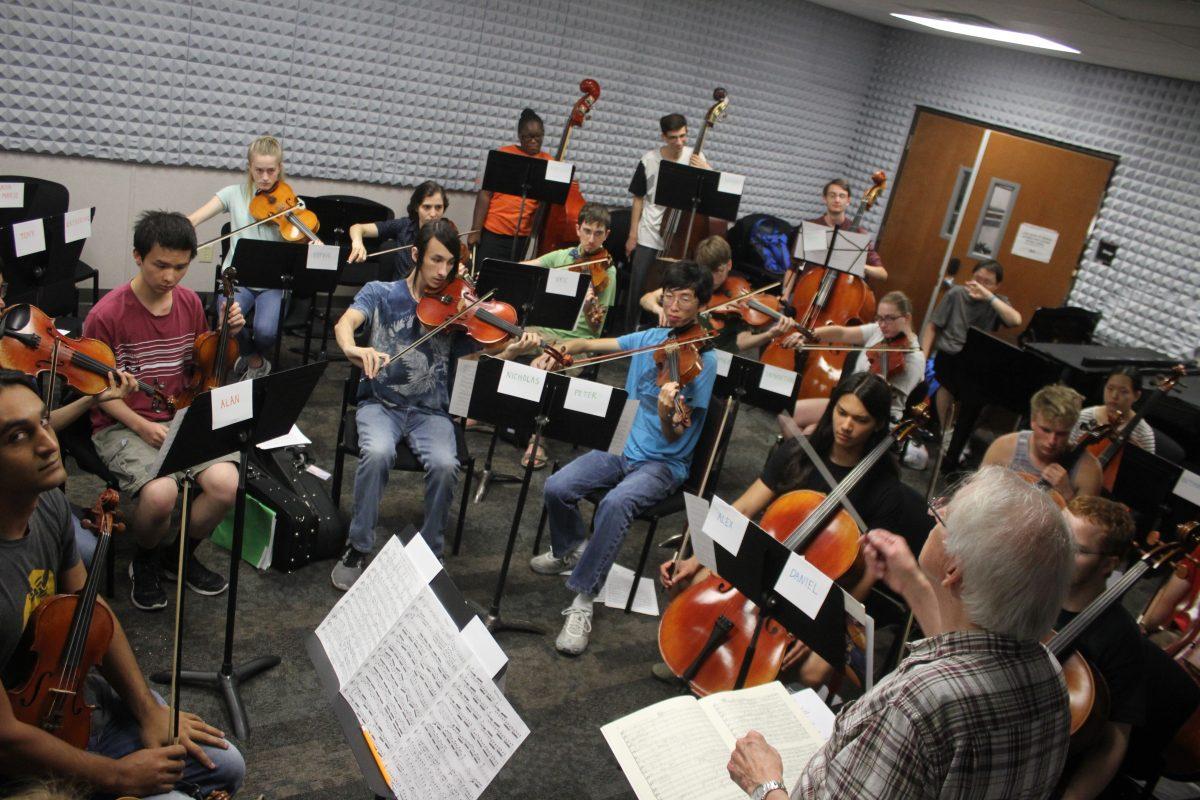Several music ensembles continue to outgrow their already-constrained practice space located in classroom building AH1. The room now has to accommodate more than 60 students, plus instruments, into a room built for 42.
Brass Ensemble Director Linda Salisbury said she worries about the health of her students far more than music quality or comfort.
“My greatest concern now is hearing loss,” Salisbury said. “The quality of music they’re producing is continually improving but we’re reaching the point where I’m concerned about their health and safety.”
During practice, students hold large instruments such as cellos and basses. Salisbury said the sound level in the room alone is overwhelming, in addition to the lack of space.
“We need square footage, but we also need higher seating and non-parallel walls and appropriate soundproofing to protect the hearing of the faculty and students,” she said.
The practice room utilized by the music groups can accommodate 35 musicians at maximum.
“Last spring, our string orchestra alone was 41 members — just the string orchestra, not including the winds, brass and percussion when we expand to full orchestra rehearsal,” Salisbury said. “The wind ensemble last fall by itself had 65 members, so it’s been very challenging to rehearse in these circumstances.”
Biology senior Monica Lou joined UTD’s music program the fall of her freshman year and has played the flute in multiple ensembles since, now serving as the president of the university musical leadership organization Comet Symfonique. She said although senior involvement in music is small, half the musicians are freshman, and the group continues to grow rapidly.
“I think several times a year we all pose for a photo where we’re nice and crammed in together,” Lou said. “I do believe that every time we rehearse we technically break the fire code, which is maybe why we have the doors open when we rehearse.”
The combined string orchestra and wind ensemble comprised nearly 40 members before Salisbury arrived at UTD in 2014. Since then, the program has grown in numbers steadily year by year.
In the fall of 2017, the combined string orchestra and wind ensemble had approximately 70 members, but the current membership reached 85 at a meeting this August.
“We have a sizeable increase in size every year, as does the university,” Salisbury said. “And you can tell across campus how difficult it is to keep the infrastructure at pace with the incoming students as we’ve grown so rapidly. This is one of the obvious places where we’ve grown out of our facilities in a very short period of time.”
There are four spaces on campus dedicated to storage for musical instruments, two of which are small closets. In the spaces for student instrument storage, anyone who has Comet Card access to the room has access to everything inside of it—including everyone else’s instruments. Due to the lack of individual lockers, instruments stacked together pose a security risk.
“The fact is that we have thousands of dollars of instruments belonging to several different people in the same room at the same time,” Lou said. “It’s an under (allocation) of resources. We don’t have the facilities to practice, the facilities to rehearse, the instruments or places to store them either.”
Lou said although the university’s primary STEAM focus and 10-year strategic plan may not necessarily prioritize the arts, music is an invaluable part of the lives of students in musical ensembles.
“Somehow, every person who comes to our rehearsals every week and dedicates three hours every Tuesday evening until almost 10 o’clock is filled with that same love for music, and the understanding that the collaboration we have every week is to make something better than ourselves,” Lou said. “When we go to rehearsals, there’s an energy in the air, partially because the room is small, but also because the passion is really big.”
Computer science sophomore Puya Gharahi serves as the communications director for Comet Symfonique. Gharahi said he shows up early to Tuesday evening rehearsals to help set up.
“It’s really claustrophobic,” Gharahi said. “It’s like, ‘Where can we put this chair so they can sort of be in the right spot?’ Usually we have to take excess stuff out of the room like the stand racks just so we can have room for chairs. Once the rehearsal starts it gets really hot because there’s so many people in such a small space. We have our violin section practically out the door.”
Gharahi has played the violin for the last eight years. He said although his high school director encouraged him to go into music, he chose computer science at a school where he could continue pursuing his passion for music.
“No one here is a music major so we get together Tuesday nights — not because we have to or to do it for a degree plan, but because we all like music,” Gharahi said. “We all love music and that’s what I really like at UTD. That doesn’t happen (at) many other places.”
Salisbury said the best option for improvement would be a space created for a larger group, with two separate halls for a 100-piece orchestra and 100-piece band.
“I love that the students, despite our challenges, continue to have positive experiences,” she said. “We just need room to grow.”











